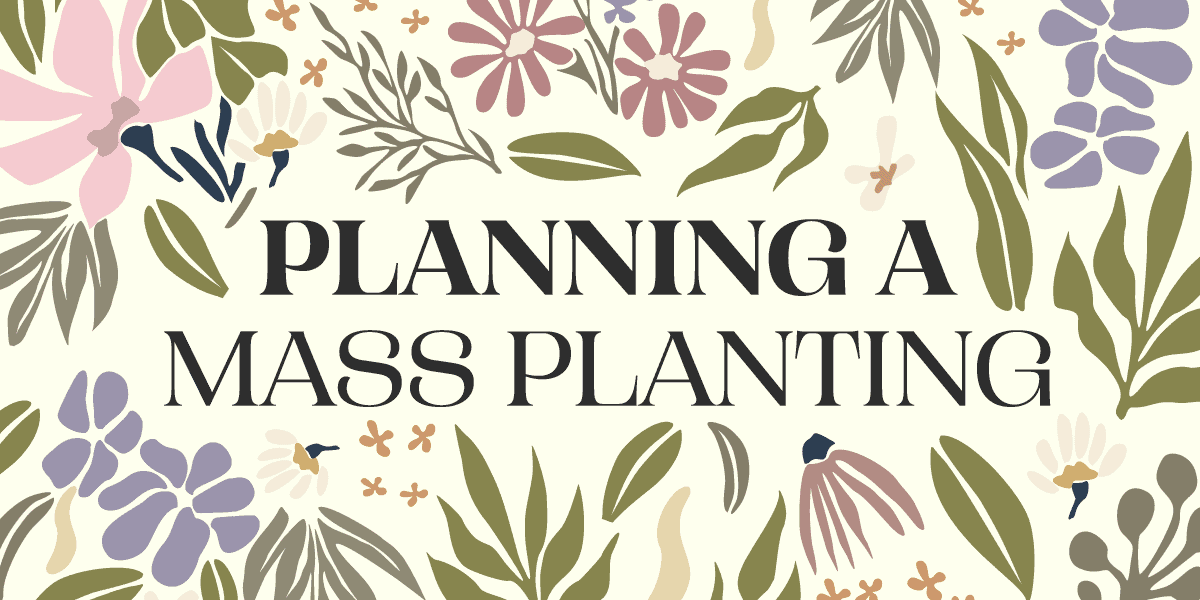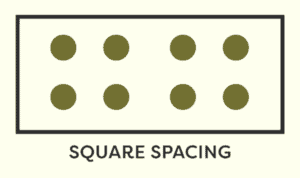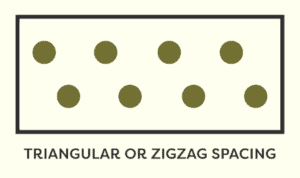One of the hardest gardening jobs is planning. How will I get the best look for my money and effort? Anwalt Garden Center offers one hint for a beautiful garden every time: Mass Planting.
Have you ever seen an old-fashioned garden with “one of everything?” These “Cottage Gardens” are quaint and perfect for providing you with flowers for cutting and drying, but on the whole are somewhat unkempt in a natural way.
Modern lifestyles require that our landscapes be noticed. Mass planting of any landscape plant will give a feeling of continuity and space in crowded urban neighborhoods and provide the visual impact that we all want.
To plan for a mass planting, first you must know how much space you are about to plant, measured in square feet. Multiply the length of your garden by its width (all measured in feet). This figure will be the area of your garden in square feet.
Example
length = 15 feet
width = 5 feet
total = 75 square feet
Next, you should ask one of the nursery professionals at Anawalt how much space to allow between your chosen plants. Then, using the following charts, find the factor that will calculate the total number of plants for your garden when multiplied by your garden’s square footage.
NOTE: For our examples, we’ve used 100 square feet as a guide. This would be an area of 10 ft x 10 ft or something similar. (Smaller, narrow beds would require more plants per square foot.)
Plant & Bulb Spacing
Number of plants or bulbs per 100 square feet if planted on:
2″ Centers = 3600 (36 sq ft)
3″ Centers = 1600 (16 sq ft)
4″ Centers = 900 (9 sq ft)
6″ Centers = 400 (4 sq ft)
8″ Centers = 225 (2.25 sq ft)
12″ Centers = 100 (1 sq ft)
15″ Centers = 64 (.64 sq ft)
18″ Centers = 45 (.444 sq ft)
24″ Centers = 25 (.25 sq ft)
36″ Centers = 12 (.111 sq ft)
48″ Centers = 7 (.0625 sq ft)
The advantage triangular spacing has over square spacing is that any given area appears fuller as the plants are growing because the spaces between the plants are filled in by each succeeding row.
Number of plants or bulbs per 100 square feet if planted on:
2″ Centers = 4150 (41.5 per sq ft)
3″ Centers = 1782 (17.8 per sq ft)
4″ Centers = 1000 (10 per sq ft)
6″ Centers = 461 (4.61 per sq ft)
8″ Centers = 263 (2.6 per sq ft)
10″ Centers = 166 (1.66 per sq ft)
12″ Centers = 115 (1.15 per sq ft)
15″ Centers = 74 (.738 per sq ft)
18″ Centers = 51 (.512 per sq ft)
24″ Centers = 27 (.27 per sq ft)
36″ Centers = 19 (.189 per sq ft)
48″ Centers = 8 (.0725 per sq ft)
Let’s say you have chosen Giant Liriope for a mass planted ground cover bed totaling 75 square feet. Giant Liriope (a one gallon size) needs to be planted about 18 inches apart in triangular spacing for best coverage. The number of plants required per square foot planted at 18 inch triangular intervals is .512. Now, look below and see what this totals.
Example
plants per square – .512
square feet in garden – 75
total plants needed – 39
Round Beds
Round beds require a little bit more effort to figure out, so we’ll provide you with calculated square feet for certain circular sizes. Decide on the method of planting you want to use (zig-zag or rectangular), the spacing required for your plants, and multiply to get the estimated number of plants required.
Diameter and Sq. Ft.
2 feet, 3.75
3 feet, 7.0
4 feet, 12.5
5 feet, 19.5
6 feet, 28.25
7 feet, 38.5
8 feet, 50.25
9 feet, 63.5
10 feet, 78.5
12 feet, 113.0
14 feet, 154.0
16 feet, 201.0
18 feet, 254.4
20 feet, 314.1
22 feet, 380.0
24 feet, 452.3
26 feet, 530.8
28 feet, 615.7
30 feet, 706.7
32 feet, 804.1
34 feet, 907.7
36 feet, 1017.7
The following example shows what a round bed 12 feet in diameter of Giant Liriope would require for complete coverage at 18 inch zigzag spacing.
Example
plants per square foot – .512
square feet in bed – 113
total plants needed – 58
NOTE: You can use larger spacings, but remember that the longer your plants take to cover ground, the longer you will have to keep weeds from taking over your planting.



